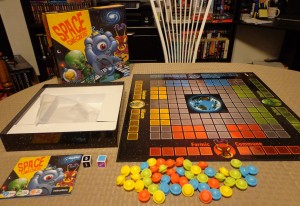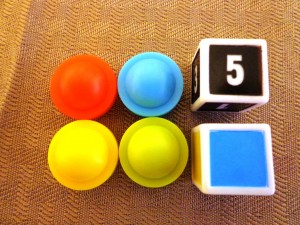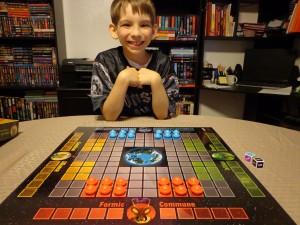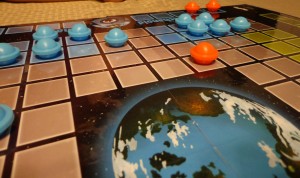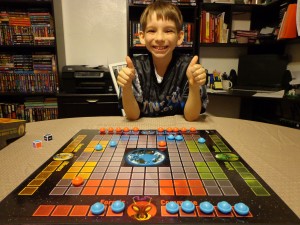It’s Checkers…in SPACE!!! Four different alien species have their eyes…or whatever they use…on Earth and they aren’t afraid to fight for it. Each alien race has their own selfish agenda and will do whatever it takes to be the last alien standing.
Space Checkers is a two to four player game that puts players in the role of one of those alien races. Players will be rolling dice and moving their UFOs in an attempt to capture their opponents’ UFOs. Before I get into specifics in regards to rules and gameplay, I’d like to once again thank Sarah Leach from Wiggles 3D for sending me a free review copy.
Components
Board & UFO Pieces – Players will be moving their UFO pieces along the playing board. The middle of the board shows a picture of Earth and is considered out-of-bounds. The colored spaces indicate the starting locations of a player’s UFO pieces.
Dice – There are two dice…one with colors on it (which indicates direction) and one regular die (which indicates how far a piece should move).
Setup & Gameplay
Players choose a color and place their UFOs on the predetermined starting locations as shown on the board. In a two player game, players should choose two colors that are opposite of each other.
On a player’s turn, they will roll both dice and pick one of their UFO pieces to move. The colored die indicates what direction that the player should move their piece towards while the numbered die tells the player how many spaces to move it. Two of the spaces on the colored die are wild, meaning that players can move their piece in any direction they wish. Should a piece ever reach an opponent’s starting area (the spaces behind Earth, called the wild area), then they can ignore the colored die when moving that piece as long as they remain in that area.
Players capture a piece when they jump over it with one of their own, though pieces can’t jump over two enemy pieces that are adjacent to one another (in the direction of the jump). Earth cannot be jumped over nor can players jump over their own pieces. If a player can’t move a piece legally after rolling the dice, they give up their turn. Lastly, pieces can warp from one end of the board to the other, following the direction in the same row it started from.
The first player to capture ten of the UFO pieces wins the game!
The above is simply an overview of the game, but should give you an idea on how it is played. I was unable to find a manual on the Wiggles 3D website to link for your viewing pleasure, so if you have any questions, feel free to ask them in the comments below.
The Review
Space Checkers is very colorful and nice to look at. It certainly draws attention from across a room. The pieces and the dice themselves are sturdy and I have no complaints in regards to the quality of the components.
I wasn’t sure how I’d feel about introducing a dice mechanic to the game of checkers. I was afraid that adding dice to a game where players had full control of their pieces would reduce the strategy factor involved…dice can sometimes mess up someone no matter how well they play. I won’t go far as to say that the amount of thinking involved is less than conventional checkers, but I will say that a dice mechanic changes it. I still had to think about which pieces I should move where, based on the dice rolls. The randomness of the dice added its own strategy to the mix, as I often had to plan for contingencies that may or may not happen.
Vinnie (11) beat me in our game, having more luck with the dice than me. The ability to warp to the other side of the board worked well to his advantage and he captured many of my pieces by doing so. I’d be interested to see how well the game would work if I eliminated the warp mechanic…something to try at any rate. Things were definitely chaotic in the beginning of the game and pieces were being jumped over left and right, though the game slowed down for us as we captured more and more pieces. Playing a three or four player game will shorten the play time, as there are more pieces involved and the goal of capturing ten UFOs remains the same. There is nothing to prevent kids from teaming up on one another, so parents beware.
Speaking of teaming up, if players get tired of every person for themselves, they can team up for a two on two match. There’s a lot of flexibility here since no color is in a better position than the other. One player could assume the role of two colors and take two turns against a team of two, assuming you had three players. By that same token, two players could control two colors each and take turns moving them however they’d like. Creative players will find the floor open to whatever variants they can conjure up.
All in all, Space Checkers is fairly deep in terms of strategy and adds a fun twist to the game of checkers. It is pretty easy to play, so it should appeal to a wide range of people and to players of all ages. It’s a bit more chaotic than standard checkers, what with the dice and warp mechanic, but it remains to be a fun way to spend the evening with the kids.
Final Verdict: 6/10
—
—
To read more about “Space Checkers”, please visit the following websites:

